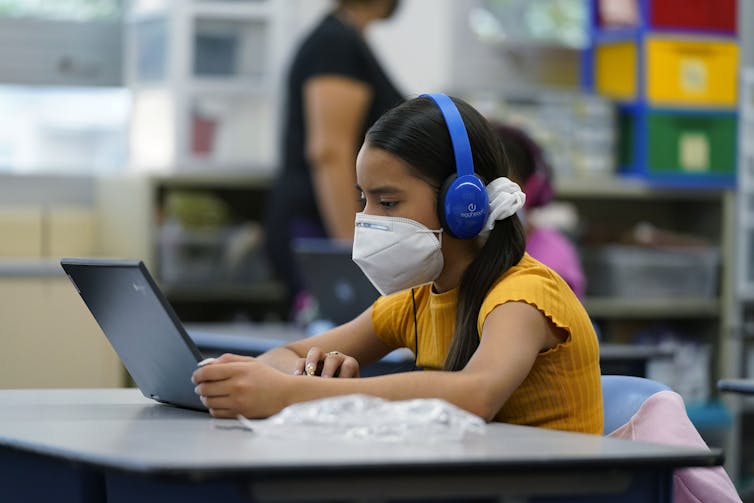Making the most of K-12 digital textbooks and online educational tools
- Written by Kui Xie, Cyphert Distinguished Professor; Professor of Learning Technologies; Director of The Research Laboratory for Digital Learning, The Ohio State University
 Millions of U.S. students are engaged in remote learning.Ethan Miller/Getty Images North America
Millions of U.S. students are engaged in remote learning.Ethan Miller/Getty Images North America
Whether children are currently going to school in person, learning remotely or doing a mix of both, digital tools and texts are becoming much more commonplace for K-12 education during the COVID-19 pandemic.
I’m a professor who researches the use of technology in education. I’m also the father of three children between the ages of 4 and 9 who are all learning from home. You might think it would be easy for me to get used to this new normal. Sadly, that’s not true.
Despite all my technical know-how, even I struggle to manage the large variety of digital tools and apps that my children use for schoolwork, let alone the numerous websites, accounts and passwords from their classes that my family has to keep track of.
Beneficial but complex
The transition from relying mainly on physical textbooks printed on paper to digital educational content, tools, apps and other resources was was already underway long before the pandemic. K-12 teachers use everything from online videos to interactive websites and from games and apps to digital textbooks that meet state standards.
I believe digital educational resources have a lot going for them. In contrast with the static text in physical books, digital resources involve dynamic content such as audio, video and animations. They may also have components like games and simulations that let kids interact with technology or each other.
Some are equipped with adaptive and smart features that automatically tailor the instruction according to individual students’ mastery levels. For example, “intelligent tutors” use complex algorithms and artificial intelligence to mimic human tutors and provide students with a personalized learning experience.
These apps, texts and tools make it easier to search for key terms, take notes that kids can find and use later, assess mastery and get creative by making charts and doing other things that are typically harder to do on paper.
 Some Denver K-12 students are remote-learning at public school sites, with staff support.AP Photo/David Zalubowski
Some Denver K-12 students are remote-learning at public school sites, with staff support.AP Photo/David Zalubowski
Wise use
With more students having their own school-issued tablet or laptop because of the pandemic, digital educational resources are likely to remain indispensable for modern K-12 classrooms even once life gets back to normal.
I consider this to be a good thing in general. At the same time, I have some concerns. One is that educators should not adopt and use these digital resources the same way as they might treat physical textbooks, because they have different characteristics.
Also, they may need to exercise caution in choosing digital tools and texts. Through Evaluating Digital Content for Instructional and Teaching Excellence, a state-funded project that helped schools transition to digital curriculum, my research team in The Research Laboratory for Digital Learning reviewed 1,200 digital educational resources from established educational publishers. We found that the quality of these digital products varies.
While most had good content and aligned well with academic standards, many weren’t user-friendly enough or properly geared for K-12 use.
Supporting children who learn online
No matter how good these digital resources are, they need to be integrated with all other learning activities.
For example, a math class may take advantage of the free videos available through Khan Academy, use Zoom for group work and collaboration, and use Google classroom for organizing assignments and communicating with peers and teachers.
That means there’s a lot to keep track of. Therefore, kids – until they turn 10 or so, and their parents – need a lot of help getting the hang of all this technology.
I recommend that families help children understand when, what, why and how to use everything. One way to go is to map out the variety of URLs, apps and tools used for specific classes, alongside their child’s usernames, passwords, access codes and group names, as well as schedule details. This will help kids access their digital resources for the right class and at the right time – on their own.
I also suggest that parents monitor their child’s technology usage, taking care during the day to limit distractions that can interfere with learning. When working on digital devices, with entertainment games and YouTube videos only a click or two away, kids can easily veer away from their virtual classrooms. Especially for younger children, whose self-regulation skills are not fully developed, parents and caregivers need to attend to them periodically.
In other words: Just because kids are quietly doing something on their iPad during school hours, it does not necessarily mean they are engaged in schoolwork.
[Deep knowledge, daily.Sign up for The Conversation’s newsletter.]
Parental controls can help. There are parental control features on individual devices like Apple’s Screen Time on iPads. There are also some features on internet routers like the Netgear’s Circle - Smart Parental Controls worth exploring. These features can limit what kids can and cannot do on their devices – such as buying stuff without permission.
Even where remote learning and socially distanced socializing are the norm, parents can still aim for a relatively healthy balance, to the degree it’s possible, between screen time and time spent offline. See if you can persuade your children to put away their screens before and after school and during their lunch breaks, whether it’s to exercise, read, cook or play board games.
Kui Xie receives funding from Institute for Educational Sciences, Spencer Foundation, Ohio Department of Education, Ohio Department of Higher Education, and Ohio Mayfield School District.
Authors: Kui Xie, Cyphert Distinguished Professor; Professor of Learning Technologies; Director of The Research Laboratory for Digital Learning, The Ohio State University
